
























As you can see from the front page and on page 3, concerning the closure of the TAXI-App cooperative, this has sent shock waves through the cab trade and we have received several calls from members who expressed their surprise on the closure of the app as a co-op for the drivers
Let us be honest, this is not the first time there has been controversy surrounding cooperatives run by cab drivers, supposedly for the benefit of their fellow cab drivers

We had Radio Taxis, Dial a Cab, and more recently HALTS, just a few that spring to mind

To legally demutualise a society and turn it into a private company, certain procedures need to be adhered to under FCA rules At the time of going to press, it is not clear whether such procedures were followed

As mentioned in previous issues, there is a growing concern within the trade regarding the rising costs of our vehicle - which
currently operates a monopoly within our industry
The current cost & finance of a new TXe has now reached an eye watering sum of £100k Add to this, we are now facing over 100,000 licensed PH drivers in competition for our work
For the trade to flourish in the future, we need a choice of vehicle that is more economically viable
On page 21, Micky Walker goes into the facts and figures in more detail and it is well worth a read
Once again the LCDC has had to contact TfL regarding what we believe is another breach of their licence On page 7 we have a story that should worry everybody
I can only hope that TfL investigate what we believe could be a very serious breach of the law
We at the LCDC don’t often bang our own drum when it comes to helping our members with their legal troubles. A lot of the cases which come our way with members are quite sensitive and we respect their wishes to keep things in house and out of the paper which I can fully appreciate.
However, not only do Payton’s Solicitors offer our members a 24 Hour Duty Solicitor 365 days a year, but since getting involved with the Club, our solicitor Keima Payton has the distinction of having a 100% success rate in all her cases which she has handled on behalf of the Club’s members.
Keima Payton has a fearsome reputation in court and should ever the need arise you will find no one better able to fight your corner and save your Badge than Keima.
- Grant Davis, LCDC Chairman

The announcement that TaxiApp was closing its co-operative has sent shockwaves through the industry
Scott Wolseley, a director of the cooperative who was suspended by the board, told the LCDC that members had been informed on March 22nd 2023 that CEO Philip Ferrigno had overseen the closure of the cooperative
Scott told the LCDC:
“As a director of TAXIAPP, this has come as a complete shock to me and I am of the firm belief that no one person had the authority to close the cooperative, especially one that drivers had paid into over a six year period
“TAXIAPP’s own cooperative rules state:
“A Director shall declare an interest in any contract or matter in which s/he has a personal, material or financial interest, whether directly or indirectly, and shall not vote in respect of such contract or matter, provided that nothing shall prevent a Director voting in respect of her/his terms and conditions of employment or any associated matter
“The fact they shifted to an investorpartnership via what we would argue could be questionable proceedings, did NOT give them the right to close down the cooperative and we will endeavour to seek what assets/data the cooperative owned, so that members can be reimbursed - or at the very least can go to benefitting one of our great charities
“The fact that it is claimed that the TAXIAPP partnership is a totally new venture begs the questions:
- Is the partnership using cooperative artwork, absorbing into another business?
- Did the coop pay for goods to be used in another business?
- Did they take stand-down pay to prepare for another business?
- Is the Taxiapp UK twitter feed directing you to the partnership? The account was established under the coop.
- Is the partnership using the coop super-side - paid for by members of the coop?
- Is the partnership using the coop logo and tag line - paid for by
members of the coop?
“All past members and the trade deserve answers Taxiapp partnership did not convert from the Cooperative, so how do they establish ownership?”

Looking at TaxiApp’s filings on Companies House, it appears that two sets of accounts were filed in February and July 2022, which begs the question why the cooperative was only shut down last month
Defending the move, the board published the following statement:
“Taxiapp as a cooperative was failing Some may not like this, but it’s the truth The accounts can be found at https://mutuals fca org uk/Search/Soci ety/30325 We’ve nothing to hide and unlike some claim, there was nothing to steal
Could it have been saved? If more money was paid by members each month, potentially yes. But we’d have had no scope to grow
Even if we had the 5000 drivers claimed (the reality was we had c1200 at the high point and c800 at the end) rising Gateway costs would have eaten the extra money We’d have been kicking a can down the road
Most importantly, when asked, not enough members wanted to pay more And as a cooperative, we had an obligation under cooperative rules not to fall into debt

Therefore, on 14th February 2022, a vote was held to decide if we should start a new company that allowed us to take investment, which overwhelmingly passed The final subs were then taken in May 2022
Rather than being a smoking gun, the closure of Taxiapp UK Limited (Reg No 4578) in March of this year was the final administrative step of that process
All members were already aware of its closure as it hadn’t operated since
May the year before
When the decision to wrap-up the cooperative was taken, rather than let Taxiapp die due to a commitment to an ideology, we looked at other paths, namely taking investment We secured this and the new Taxiapp was born
None of the money from the investment went to the directors, it went towards a much needed new app, administration and marketing It was also written into the business structure that without the consent of Taxiapp drivers:
The business can’t be sold
There’ll be no private hire
There’ll be no increase in commission
(We’re currently 0% commission)
While acknowledging Taxiapp’s failure as a cooperative, we also recognised the contribution that the coop’s members made. That’s why Taxiapp is 42% owned by its drivers Our goal is to repay these contributions through our profit share, with every £1 paid in subs increasing a driver’s share
If giving drivers 0% commission and a profit share, and saying no to PHV, is theft in your book, so be it We won’t persuade you otherwise As a cooperative Taxiapp was at death’s door, but it now has a new life and is growing
We genuinely respect and value all black cab drivers We have all worked too hard to have the trade taken from us If we work together we can take it back We are stronger together ”
5 Endeavour Square
London E20 1JN Grant Davis, Chairman, London Cab Drivers’ Club Unit A301 3, Tower Bridge Business Complex 100 Clements Road London SE16 4DG
Dear Helen,
Thank you for our open discussion last Thursday at the Taxi Senior Representatives meeting at which we discussed the topic of the Taxi Conditions of Fitness and the turning circle requirement Yes, I would appreciate it if you can confirm, that having had a passage of a considerable number of years since the last formal review, I think it would be appropriate for TfL to launch a new review
As you know from my letter to you in December, our belief at the LCDC is that you and your colleagues at TfL should undertake a full review of the Conditions of Fitness relating to the turning circle Such a review should not be just about how many times a taxi undertakes the lock-to-lock turning circle, although that would be useful to know I believe you should also consider other factors such as the economic impact of the turning circle requirement LCDC’s contention is that TfL should be making it more attractive for alternative low volume vehicle manufacturers to take OEM electric vehicle products and turn them into London taxis Whilst maintaining and perhaps enhancing the standards for accessibility and safety (the division), TfL should again review the need for the turning circle The 25-foot turning circle requirement adds cost, does nothing for accessibility, reduces the availability of fully electric vehicles, is arguably unsafe, is certainly less relevant in our increasingly busy, 20mph streets and will continue to perpetrate a monopoly
Monopolies are unfair and a lack of competition only results in distorted markets and higher prices Whilst I accept we are living in inflationary times, LEVC as the sole supplier of London Taxis has already increased its price by £1,500 in February this year and another £1,500 increase is due in the next couple of months As mentioned at the meeting, I am told by Colts Cabs that they have bought all their planned purchases of TXe’s this year before the price increases because the manufacturer’s plan is to have quarterly price increases
There is little or no prospect of any other vehicle entrant coming into the London market whilst the requirement for the 25-foot turning circle remains Recently there was talk of a Vauxhall Vivaro being introduced but since this would have the same design of rear wheel steering system as was included on the Mercedes Vito this must be a prospect that would cause serious anxiety for TfL and Vito Taxi drivers Achieving the turning circle (or rather not achieving it) was the reason for the demise of the Mercedes Vito Taxi, a perfectly good taxi that was plagued with rear wheel steer mechanical problems and a system that put an extra £10,000 to the cost of the vehicle, and it was hardly ever used. Even the Police consider 180-degree turns in busy streets in London unsafe, why cling on to a feature that is out-dated and potentially dangerous?
Fleets like Colts Cabs and Sherbet have become the major buyers of TXe’s because owner drivers are finding the repayments increasingly difficult to justify economically The big advantage that fleets enjoy, apart from the discounts they can negotiate (but they’re reducing as well), is their ability to off-set the VAT content of the vehicle price Currently fleet rental prices are around £375-£380 per week for a new vehicle, but as the vehicle prices continue to increase and these increases are passed on to the fleet rental customers, I know that many of my members are feeling they will not be able to afford to continue in the trade Tariff increases will not come near these increases
I have heard that some in the trade, who support the turning circle, argue that even a new all-electric Mercedes Vito would end up costing the same as a TXe The argument goes that because of parts supply problems Mercedes reduced their discounts to customers last year and when you add the conversion cost of making the vehicle into a taxi at £20,000 then the retail price would be over £70,000. Instead, I believe the electric vehicle market is now changing, supply of electric vehicles is starting to overtake demand. Tesla is offering being reductions of £10,000-20,000 on its saloon cars and Vauxhall are offering 0% finance deals on their electric vehicle range It is interesting that in January this year Carlos Tavares, the Chairman of Stellantis Group, said that his company has to cut the costs of electric vehicles if they are to be affordable for ‘the middle classes’, he said that without cost reductions EV’s will be too expensive, shrinking the market and driving up costs more Isn’t that is exactly what’s happening with our taxi prices
When I wrote to you in December there were 18,670 licensed London drivers Three months later there are now 340 fewer drivers How long can this decline be allowed to go on? The number of licensed taxi drivers is continuing to decline, week on week, month on month Older drivers are not being replaced by newer pass-outs Surely this must signal to you a serious underlying problem that the economics do not stack up for our trade
I noticed that Keith Prince recently asked the Mayor in the London Assembly to consider a review of the turning circle In his reply the Mayor emphasised the importance of accessibility We agree, it’s something we are all proud of, that London’s taxi fleet is 100% wheelchair accessible But, then so is Manchester’s taxi fleet, so is Edinburgh’s, Glasgow’s and Liverpool’s, and yet all these cities abandoned the 25-foot turning circle many years ago. The loss of the turning circle has not resulted in fewer wheelchair accessible taxis in any of these cities The Mayor also said in his response that: “Taxi fares are reviewed annually When considering changes to taxi fares Transport for London updates the taxi Cost Index The Cost Index tracks changes to taxi drivers’ operating costs and includes taxi vehicle costs ” The last TX4’s were sold for just over £40,000 in 2017 Now, 5 years later the TXe is at over £67,000 even after the £7,500 grant That’s a 65% increase I am sure you can tell me the cumulative tariff increase over the same period, but I am sure it is nowhere near 65%
I have said before that sometimes we don’t recognise a crash or a market collapse that is about to happen, but it happens all the same Then we wonder what could have been done to avoid the problems that caused the collapse At LCDC we believe there is every reason to expect, that as vehicle prices continue to increase, with higher interest rates, increasing electricity costs, these will all combine together to walk us into an inexorable but inevitable decline in London’s taxi trade All we are asking is that TfL consider how it can adjust its requirements, to maintain the best standards but reduce the barriers to entry and enable more fully electric taxis to enter the London market I look forward to hearing from you
Kindest regards
Grant

The London Cab Drivers Club

From the outset, the LCDC votes at every AGM on keeping the C O F, or not, regarding the taxis we use and as it stands at the last AGM, the LCDC membership voted to retain the conditions of fitness
That was pre-pandemic and as we know the trade has changed since 2019 I have been asked on twitter why the LCDC has spoken about different vehicles coming into the London market and I truly believe

the current monopoly we have now is not healthy Opposite, you can read my recent email to Helen Chapman at TfL which hopefully sheds some light on the wider picture, and with increases of £1,500 every quarter (I am led to believe) I cannot see the situation changing
With now over 100k PH drivers licensed and a taxi costing over £100k to buy on finance, we need to look at how we get older drivers back into the trade The
221 miles range, price from £51k, charges 80% in 40 mins, stereo, reverse cameras and a range of 2,3,4, years Mercedes service packages.
demographics show we have more drivers over 50 than under 30, so if you had to give up working over the Covid pandemic, how do we get drivers back into a cab when rentals are £350+ and the other alternative is to sign up for a £100k finance agreement? Some drivers could not get finance on such a large amount if they wanted to
We are shrinking as an industry and part of the problem apart from the
KOL numbers are the lack of affordable taxis When I attend meetings at TfL and hear the argument from the PH industry on how the English requirement test and the enhanced driving test is a "Barrier To Entry" I say what about doing the KOL for three years and then having to pay £100k to go to work? That's what I call a real barrier to entry!
The turning circle should be (in my opinion) be a driver’s choice and if we scrapped it the vehicles coming into
London should only ever be black in colour and retain all the existing features such as wheelchair / hearing loop / steps / seating, in fact everything we currently provide to our passengers
Like everyone reading the Badge, I want our industry to flourish and prosper and whilst I love the look and the drive of the TXe, I believe we should be able to have a wider choice
230 mile range, price £55k, has a 215 bhp electric motor and comes with a 125kw fast charger with up to 80% charge in 40 mins. Has a panoramic glass roof and comes with Bang 7 Olufsen stereo. Ford service packages available.

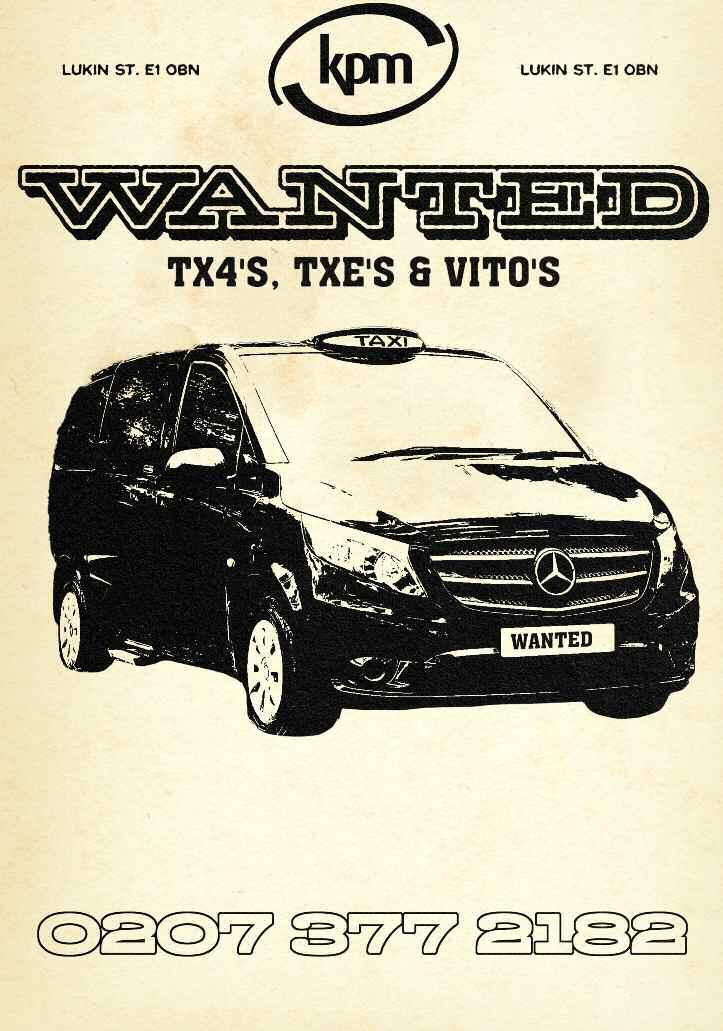

I hope you both had a relaxing Easter ( and not too many eggs )
I was contacted by a driver on Saturday regarding an incident he witnessed on Friday 7th April at around 11 30 / 12pm in Evering Rd E5
My member found himself behind a silver PH vehicle (photo attached ) with a Wolverhampton licence plate attached to his boot The car kept slowing down as if looking for something and when he turned right into Evering Rd E5 he followed him
After around 50 yards the car stopped and a lady alighted from the vehicle. My member who was behind him asked the lady where she had been picked up from and she said
locally in Hackney My member then asked her if it was Uber and she replied, ‘No, it’s Bolt.’
When my member explained that the car was licensed not in London but in Wolverhampton and not legally insured, she was very upset and said she had no idea it was from Wolverhampton
In the February edition of the Badge we raised with you the issue of Wolverhampton PH working in London and that Bolt had put out a message to drivers not to pick up jobs in areas where they are not licensed to do so Why were Bolt asking drivers not to accept, unless the booking goes direct to the driver, a breach of section 2 1998 Act?
London traffic is becoming worse despite a string of policies brought in by Sadiq Khan, the Mayor, aimed at reducing it across the capital.
In its annual Global Traffic Scorecard, Inrix, a data firm, found that London topped the list of 1,000 cities as the place with the worst congestion for the second year in a row, with drivers losing just under a week of their year stuck in traffic
The 156 hours of congestion in London put it above second place Chicago, where drivers spend 155 hours in jams, and Paris, where they spend 138
hours It is also nearly double the UK average, with Britons losing 80 hours per year to traffic delays

The latest figures, which increased by five per cent compared to pre-Covid, will come as a blow to the Mayor after policies including Low Traffic Neighbourhood (LTN) zones were introduced to bring down congestion and pollution
LTNs have attracted widespread criticism, with some arguing that they push traffic to nearby streets and result in drivers spending more time stuck in traffic
We are still awaiting your response on this question and maybe this email may provoke you into investigating their booking system and getting back to the Club
Detail: Friday 7th April time: 11 30 - 12pm

Evering Rd E5
Driver: black male 40 - 50 age
We at the LCDC look forward to your earliest reply in this serious matter
Grant Davis Chairman LCDCMr Khan also brought in the Ultra Low Emission Zone (ULEZ) charge in in August 2019, which requires the highest polluting vehicles travelling in central London to pay a £12 50 per day
The charge is now set to be introduced across greater London, including its outer boroughs, from next August, a move described by Gareth Bacon, a London Conservative MP, as “the worst assault on drivers we’ve ever seen”
The Greater London Authority Conservative group said Mr Khan was pushing the wrong approaches, claiming his policies punished drivers by reducing roadspace and went against the wishes of most people
Nick Rogers, a GLA assembly member and the group’s transport spokesman, said: “If the Mayor genuinely wants to reduce congestion, he needs to make greener forms of
transport more accessible and practical, especially in outer London ”
A spokesman for the Mayor of London said he was committed to tackling the triple challenges of toxic air pollution, the climate emergency and congestion, adding: “This is why he made the decision to expand the Ultra Low Emission Zone (ULEZ) London-wide ”
Courtesy of The Daily Telegraph
Parisians have voted to rid the streets of the French capital of rental electric scooters, with an overwhelming 90% of votes cast supporting a ban, official results show.
Paris was a pioneer when it introduced e-scooters, or trottinettes, in 2018 as the city’s authorities sought to promote non-polluting forms of urban transport

But as the two-wheeled vehicles grew in popularity, especially among young people, so did the number of accidents: in 2022, three people died and 459 were injured in e-scooter accidents in Paris
In what was billed as a “public consultation” voters were asked: “For or against self-service scooters?”
Twenty-one polling stations were set up across the city and were open until 7pm local time Although 1 6 million people are eligible to vote, turnout is expected to be low
The ban won between 85 77% and 91 77% of the votes in the 20 Paris districts that published results, according to the City of Paris website on what was billed as a rare “public consultation” and prompted long queues at ballot boxes around the city The vote was non-binding but city authorities have vowed to follow the result
Paris’s socialist mayor, Anne Hidalgo, has promoted cycling and bike-sharing but supported a ban on escooters
In an interview with Agence France-Presses last week, Hidalgo said “self-service scooters are the source of tension and worry” for Parisians and that a ban would “reduce nuisance” in public spaces
Paris has almost 15,000 escooters across its streets, operated by companies including Lime, Dott and Tier Detractors argue that escooter users disrespect the rules of the road and
regularly flout a ban on riding on pavements The vehicles are also often haphazardly parked or thrown into the River Seine
In June 2021, a 31-year-old Italian woman was killed after being hit by an e-scooter with two passengers onboard while walking along the Seine
“Scooters have become my biggest enemy. I’m scared of them,” Suzon Lambert, a 50year-old teacher from Paris, told AFP “Paris has become a sort of anarchy There’s no space any more for pedestrians ”
Another Parisian told BFMTV: “It’s dangerous, and people use them badly I’m fed up ”
Julian Sezgin, aged 15, said he often saw groups of two or three teenagers on e-
scooters zooming past cars on busy roads “I avoid going on e-scooters and prefer ebikes as, in my opinion, they are safer and more efficient,” he told the Guardian
Bianca Sclavi, an Italian who has lived in Paris for years, said the scooters go “too fast” and should be mechanically limited so they go slower “They are dangerous because they zip in and out of traffic,” she said “However, it is not as bad as when they first arrived the most dangerous are the drunk tourists!”
She is not planning to cast a vote “There are more serious matters right now –[what about] the rubbish? Pension reforms? Immigration? I don’t think it was such a good idea for Hidalgo to make such a big deal out of this I really like what she is doing with the
bike lanes, but she should not spend so much energy on the scooters ”
However, Linda Joèlle, 35, spoke out against a ban “Now that I have found an excellent way to get to work, and one that is better for the environment, they are trying to ban it,” she said “They keep changing the rules ”
One unnamed student supporting e-scooters told BFMTV: “I don’t live so close to the Métro and so it’s better to go to school on the escooter ” Another said: “Where I live, it’s better than going by foot ”
The French transport minister, Clement Beaune, told Europe 1 radio last week that he expected the vote to result in a ban, adding that “the important consultation will be watched by a lot of other towns in France and
“I find it a shame that we have caricatured and dumbed down the debate,” he said, arguing that escooters are a valuable transport solution that have replaced up to one in five journeys in Paris that would previously have been made using pollution-emitting vehicles
Meanwhile, operators of escooters fear a ban would encourage other cities to follow suit
“Paris is going against the current,” Hadi Karam, the general manager for France at California-based Lime, told AFP, citing decisions to increase the number of escooters or extend contracts in Washington, Madrid and London
Courtesy of The Guardian


We’ll arrange for the recovery of your cab into safe and secure storage until repairs are started.







We’ll arrange for repairs to be completed by an approved repairer as well as dealing with insurance assessors.




















































We’ll deal directly with Transport of London on your behalf to ensure all relevant procedures are complied by involving the accident of your licensed cab.


Once repairs are completed, we’ll deliver your cab back to your home address.


We are still renting a limited amount of diesel taxis



Sadiq Khan will face a High Court challenge this summer over his bid to expand the Ulez to the Greater London boundary, it emerged on Wednesday afternoon
A judge accepted a request from five Tory councils – Harrow, Hillingdon, Bromley, Bexley and Surrey county council – for a judicial review of the mayor’s plans, according to wellplaced sources
It is thought that the hearing - which will effectively decide whether Mr Khan acted legally or illegally in the way he gave the go-ahead for the Ulez expansion - will take place in July
A ruling against the mayor could potentially delay the August 29 expansion of the ultra-low emission zone from its current boundary just inside the North and South Circular Roads.
The five councils are understood to have been given the go-ahead to challenge the Ulez expansion on two of their five grounds of appeal
These are believed to revolve around suggestions that Mr Khan acted beyond his powers by expanding the Ulez by varying the existing scheme order rather than issuing a new charging order, and that he failed to consider including motorists living in the “buffer zone” on the edges of London in the £110m vehicle scrappage scheme
Nick Rogers, City Hall Conservatives transport spokesperson, said: "The High Court has now ruled there is sufficient evidence that Sadiq Khan’s Ulez decision may have been unlawful
“The Mayor clearly does not have the legal grounds to proceed with his Ulez tax plans, which take money from charities, small businesses and low income Londoners who cannot afford a new car Sadiq Khan should do the right thing, immediately stop work on his Ulez expansion, and explain his actions to the court "
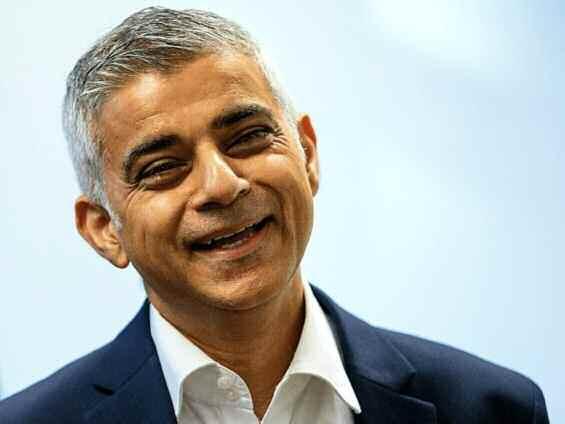
Sources said the court had only been required at this stage to decide whether the claims were arguable, and that no decision had been made about the lawfulness of the Ulez
It is understood that Transport for London will continue to defend the case
London Tory MPs including Greg
Hands, Iain Duncan Smith, Paul Scully and Gareth Bacon welcomed the news, which effectively means the claim has passed its first legal hurdle
Mr Scully, the Government’s Minister for London and a possible Tory mayoral candidate, said: “The Mayor should just accept that he needs to go back and think again how he can take Londoners along with him rather than punishing them ”
The councils had also argued that Mr Khan had relied upon “incorrect” assumptions about the number of noncompliant vehicles in the expanded zone, and there was a lack of detail in how the £160m cost of expanding the scheme, or the £200m in annual expected income, had been calculated
There was also concern over how TfL predicted future rates of compliance with the Ulez - which it expects to cease “making a profit” by 2027 due to drivers ditching more polluting vehicles.
However these three claims will no
A spokesperson for the Mayor said: “The Mayor is pleased to see the court has refused permission for the majority of the grounds We will continue to robustly defend his life-saving decision to expand the Ulez and continue with preparations without delay
“It is a shame that some local authorities have chosen to attempt this costly and misguided legal challenge instead of focusing on the health of those they represent
“Around 4,000 Londoners die prematurely every year due to air pollution This is a health emergency and the Mayor is not prepared to stand by and do nothing while Londoners are growing up with stunted lungs and are more at risk of heart disease, cancer and dementia due to our toxic air ”
According to sources, the High Court has ruled that grounds 1 ("Failure to comply with the statutory requirements in Schedule 23 and/or frustration of the statutory purpose") and 3 ("Failure to
take into account a material consideration and/or irrationality due to failure to consider the potential for inclusion of non-Londoners in the new scrappage scheme") have sufficient evidence to proceed to trial
However, the scrappage scheme claim was said to be “on the cusp” of being arguable and only part of it will be considered at the full hearing
In February, Mr Khan claimed the application was “wholly without merit” and “misconceived” and advised the councils not to waste taxpayers’ cash
About 200,000 additional drivers a day are expected to have to pay the £12 50 emissions-based levy if the zone expands to the Greater London boundary
As many as 700,000 cars registered in Greater London are thought to be noncompliant with the Ulez exhaust rules and their owners thus at risk of having to pay for each day they drive within the zone.
Courtesy of The Evening Standard









Electric cars are being written off after minor damage to batteries, casting renewed doubt on their environmental credentials
Roughly half of low-mileage EVs being salvaged have suffered minor battery damage – which can be caused by something as innocuous as mounting a kerb
according to Copart, an auction platform
A senior source in the insurance industry said car manufacturers were not sharing diagnostic data because they were wary of third parties botching repairs
As a result, insurance companies are reluctant to attempt repairs and assume responsibility should anything go wrong
“A lot of people are quite scared of what to do with them,” he said “If a car is not powered down correctly you could get electrocuted ”
It comes as the Government unveiled plans to force car manufacturers to sell an increasing proportion of EVs in the run up to the ban on petrol car sales by 2035
The source said EVs could be sent to the scrapheap for minor bumps, such as mounting a kerb
“In rare instances, the damage could even lead to a volatile situation,” he said “The battery could catch on fire ”
Batteries are the most expensive part of an electric car, accounting for around 50pc of its value, and there are “only a few qualified technicians in the UK able to remove a battery, let alone repair it”, said Chris Payne, head of engineering at motor insurer LV
The placement of the battery within an EV can make it more likely that it will be damaged in a minor accident, according to experts
This includes EVs with the common “skateboard design”,
which places the battery underneath the car
Edmund King, AA president, said: “On EVs the battery can, in effect, form part of the chassis, so if there is serious structural damage it might mean the car is written off
“However, we know that Ford, GM and others are working on repairable battery packs ”
Electric cars are typically more expensive to insure than

petrol cars because repairs are often more complex and time-consuming
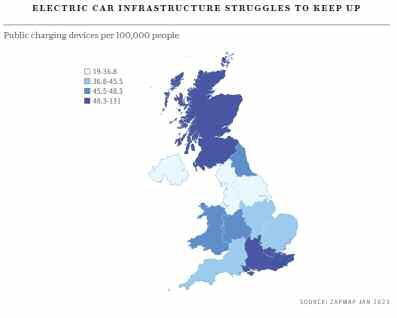
Supply chain issues with components and parts also mean drivers could be forced to wait up to a year for a replacement vehicle
The most cost-effective solution for insurers, therefore, is to scrap the entire car
Mr Payne said: “EVs are environmentally friendly, but if
you write one off questions start to be raised on the environmental impact ”
He said salvage plants have “no way of disposing” of damaged batteries “Loads of them have lines of batteries that just kind of sit there,” he added
Adrian Watson, head of engineering at Thatcham Research, an insurers' research centre, said Britain’s car industry would need to
address the issue of battery repair before 2035, when the sale of petrol cars will be banned outright
“The reality is, with price flux there are vehicles where a replacement battery is more than the recommended retail price of the vehicle,” he said
“We’re actually shredding batteries or exporting them to Europe because the facilities don’t exist in the UK yet ”
Jonathan Fong, senior policy adviser at the Association of British Insurers, a trade body, said the Government would need to invest heavily in retraining technicians in EV repair to meet its 2035 targets for zero emission vehicles
“There also needs to be more investment and collaboration with relevant groups to ensure the development of commercially viable and environmentally sound battery repair, recycling, and end of life processes,” he added Industry experts believe the infrastructure to support electric cars will expand as uptake increases Batteries no longer suited for cars could also be repurposed for use in homes or solar farms, Mr Watson said.
He added: “All of these challenges are solvable There’s no reason why we can’t design repairable batteries, and when that can’t be done we can repurpose them
“But the reality at the moment is that’s not that case – there’s no strategy The problem is we can’t diagnose batteries that are probably fine because we just don’t know
“There’s an immaturity about the way it’s been done Thinking about battery health after an accident is not the first thing people consider.”
The The Department for Business and Trade has been approached for comment
Courtesy of The Daily Telegraph







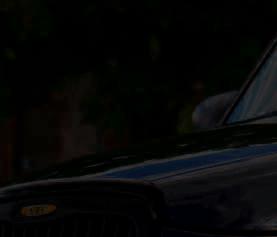



charged more than the TfL regulated booking fee What the trade needed was a fair App where the drivers got all the fare This isn’t a commercial venture, this idea for the app, has come from the heart of someone who cares for the trade made possible by the wonderful and unexpected legacy from Barbara ”
Brian Heffernan, London
London cab driver and Taxi Charity volunteer
Micky Harris has used an unexpected legacy from his late wife Barbara to create the Unify London App Barbara regularly joined Micky on Taxi Charity trips to the continent before her death and she left instructions that Micky was to use the legacy to support the cab trade and help charities run by taxi drivers
The Unify London App is very different to anything else that is currently available to London cab drivers There is no surge pricing, no hidden fees, no cancellations, hired from the hail, light off-meter on and
unlike other Apps the Unify London App will give cab drivers the full metered fare In addition, charities including the Taxi Charity for Military Veterans, The London Taxi Drivers’ Charity for Children, The Albany Taxi Charity and the Magical Taxi Tour will benefit every time the app is used
Micky Harris, London cab
driver and Taxi Charity volunteer said, “Adjusting to life without Barbara has been incredibly difficult However, when Barbara passed, she left me a wonderful legacy, asking me to use the money to unify the cab trade Understanding and formulating how best to use her legacy has undoubtedly given me something to get up for
every day; I knew that I wanted to combine Barbara’s love of the Taxi Charity with her wishes to support the cab trade and the result is the Unify London App
“While I was developing the App it was very important to me that the driver received the full metered fare and that the customer is never

Cab driver and Chairman of the Taxi Charity for Military Veterans said, “Micky has been a wonderful volunteer for the Taxi Charity and we have recently asked him to join the committee His late wife Barbara was an important part of our trips with veterans to the Netherlands and Normandy and I know how very proud she would be of Micky creating this cab app which will benefit drivers and support the Taxi Charity and other trade charities ”
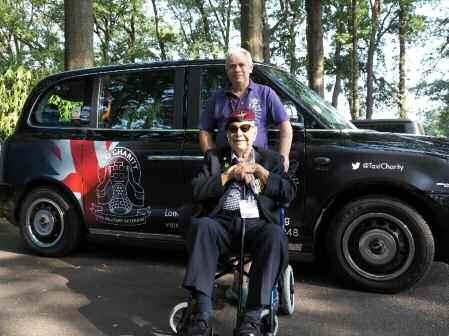
Unify London has no surge pricing, no hidden fees, no cancellations, the cab driver receives the full fare and the customer is never charged more than the TfL regulated booking fee It is the only platform operating fully within TfL pricing structures
www unifylondon com


24 HOUR DUTY SOLICITOR EXCLUSIVE TO THE CAB TRADE
Your 24 Hr duty solicitor hotline membership card
Peace of mind 24 hrs of the day
LEGAL COVER
Our fantastic team of City Of London based solicitors and barristers, experts in Hackney Carriage and road traffic law
COMPLAINTS AND APPEALS
As a member of the LCDC, we will deal with any complaint that has been made against you by members of the public
Also we will attend the LTPH with you on any personal appeals that would affect your licence




HEATHROW AIRPORT REPRESENTATION
With our reps at the airport working
hard on the trade’s behalf for a fairer, and more safer future at Heathrow
RANKS AND HIGHWAYS
The LCDC attend the Joint Ranks committee, working hard for more ranks and more access for the taxi trade in London
CAB TRADE ADVICE

All members can call the office for any information or up to the date news on any trade related subject
TRADE’S FUTURE
The Club worked tirelessly in bringing in the green & yellow identifiers to the taxi trade And are always working hard to protect our future

CAB TRADE REPRESENTATION
We are working hard to work with members of the GLA and also politicians to fight our corner against TFL and was a major influence in the recent “ future proof” document
VEHICLE MANUFACTURERS
The Club works alongside LTC and Mercedes to deliver a vehicle that meets
our standard as a London taxi driver

Recently we have held meetings to work against the ULEZ strategy and the introduction of taxi age limits
CLUB PROTECTA
To help drivers who have acquired twelve points keep their licence

:The origins of the word Cockney lay in an insult to Londoners by more rural northern Englishmen... from the Middle English "Coken + ey" meaning misshapen eggs, later to be portrayed in Chaucers Canterbury tales "Cokenay" as "a child tenderly brought up", and "an effeminate town dweller".
When London consisted of little more than the walled City, the term cockney applied to all Londoners and this lingered into the 19th century As the city grew the definitions shifted to alternatives based on more specific geography, or of a certain dialect The terms "East End of London" and "within the sound of bow bells" are used interchangeably, and the bells are a symbol of East End identity.
The area within earshot of the bells changes with the wind, but there is a correlation between the two geographic definitions under the typical prevailing wind conditions The term is now used loosely to describe all East Londoners, irrespective of their speech
The traditional core districts of the East End include Bethnal Green, Whitechapel, Spitalfields, Stepney, Wapping, Limehouse, Poplar, Haggerston, Aldgate, Shoreditch, the Isle of Dogs, Hackney, Hoxton, Bow and Mile End This area, north of the Thames, gradually expanded to include East Ham, Stratford, Leyton, West Ham and Plaistow as more land was built upon
The church of St Mary-leBow is one of the oldest, largest and historically most important of the many churches in the City of London The definition based on being born within earshot of the bells, cast at the Whitechapel Bell Foundry, reflects the early definition of the term as relating to all
The audible range of the Bells is dependent on geography and wind conditions The east is mostly low lying, a factor which combines with the strength and regularity of the prevailing wind, blowing from west-south-west for nearly three-quarters of the year, to carry the sound further to the east, and more often.
A 2012 study showed that in the 19th century, and under typical conditions, the sound of the bells would carry as far as Clapton, Bow and Stratford in the east but only as far as Southwark to the south and Holborn in the west An earlier study suggested the sound would have carried even further, as far as St Marylebone
The 2012 study showed that in the modern era, noise pollution means that the bells can only be heard as far as Shoreditch But according to legend, Dick Whittington heard the bells 4.5 miles away at the Highgate Archway, in what is now

But the study also concluded that it is credible that Whittington might have heard them on one of the infrequent days that the wind blows from the south
The church of St Mary-leBow was destroyed in 1666 by the Great Fire of London and rebuilt by Sir Christopher Wren
Although the bells were destroyed again in 1941 in
the Blitz, they had already fallen silent on 13 June 1940 as part of the British antiinvasion preparations of World War II The period before they were replaced in 1961, meant that by the "within earshot" definition, no "Bow Bell" cockneys could have been born
Today, the use of such a literal definition produces other problems, since the area around the church is no longer residential and the
noise pollution means today, few are born within earshot
Cockney speakers have a distinctive accent and dialect, and occasionally use rhyming slang The Survey of English Dialects took a 1940’s recording from a longtime resident of Hackney, and the BBC made another recording in 1999 which showed how the accent had changed

The early development of Cockney speech is obscure, but appears to have been heavily influenced by Essex and related eastern dialects, while borrowings from Yiddish, including kosher (originally Hebrew, via Yiddish, meaning legitimate) and (stumm, originally German, via Yiddish, meaning mute), as well as Romani, for example wonga (meaning money, from the Romani "wanga" meaning coal), and cushty (Kushty) (from the Romani kushtipen, meaning good) These cockney words reflect the influence of those groups on the development of the speech
John Camden Hotten, in his Slang Dictionary of 1859, makes reference to "their use of a peculiar slang language" when describing the costermongers of London's East End
A dialectological study of Leytonstone in 1964 (then in Essex) found that the area's dialect was very similar to that recorded in Bethnal Green by Eva Sivertsen...but there were still some features that distinguished Leytonstone speech from cockney
The districts to the south of Waterloo, London and Tower Bridges were cockney speaking areas, before redevelopment changed the working-class character of the neighbourhood, so that now, Bermondsey is the only cockney dialect area south of the River Thames


¬The VAT threshold is takings of £85,000 Now, if you’re a sensible 40 hours a week man or woman, you have nothing to worry about If you’re the kind of leather arse that wants it all, you may be sailing close to the wind If a driver is doing 6 days a week and 12 hours a shift, there is a chance that the VAT man could be knocking at the door
If that’s the case, it’s going to get interesting. I seem to recall that when VAT was first introduced in the early 70s, the cab trade gave up the right to claim back VAT for 5p added to the meter. Even if this isn’t the case, a driver may not charge more than the meter so cannot add VAT to the fare TFL cannot incorporate VAT into the meter because the overwhelming majority of drivers will not be registered for VAT and would effectively be over - charging the customer by 20%
So, if a driver hits £85,000, there will be £17,000 VAT owed on sales Fair enough, the driver can reclaim VAT on most of his expenditure but will still be out of pocket by a net £10,500 However, the reduced takings will reduce income tax.

Nevertheless, when everything is taken into account, a driver that only works until he/she has takings of £80,000, will probably be better off than the driver that works until reaching takings of £85,000 and registering for VAT, by around £5,000
We already have a situation where the taxi supply is already falling due to drivers being unable to rent/buy a cab and the numbers leaving the trade through age, etc are not being sufficiently replaced by new drivers To add self – restriction of working hours to this is dopery Something needs to be sorted out now before it
happens TFL/government, just for once, needs to be proactive instead of reactive
Even considering the possibility that a cab driver may be taking £85,000 a year, seems ridiculous I started driving a cab in December 1979 I can’t find records going back quite that far but I can go back to 1984 My average daily takings through March and April were £61 50 per shift and a new cab cost me £10,071
Today, a new cab would cost me £67,872, after the government grant that will soon be phased out and then the price rises to £75,372 If my takings had risen in line with cab price rises, my daily average takings would have to be £415 to keep up with vehicle inflation Forget for a moment the ludicrous idea that a driver can make takings of £415 per shift consistently and imagine it could be so What a joke! Even with takings like that, I’d still be worse off because

I would be paying 20% VAT and some of my earnings would be taxed at 40% instead of 20%
Of course, this isn’t reality but simply a model to show just how much the price of a cab has affected your cost of living The cab is brilliant; I love the TXe. However, it’s just too damn expensive and that isn’t even the manufacturers fault The market is too small to make scale economies in the design and build Whatever the reason, the price of a cab has risen by 674% since 1984 and that is way above inflation
The price of a Ford Mondeo has risen by not much more than half that inflation, at 360% Admittedly, that is for a hybrid rather than electric but then as a working vehicle the Txe isn’t really an electric vehicle either You may have heard about the new Ford electric taxi, perhaps in this issue We can’t use it because it doesn’t meet the turning circle requirement If we could though, it would be almost £10,500 cheaper
than a TXe and with a 274 mile range
Now, I’ve heard somebody in the trade say that it wouldn’t be worth dropping the turning circle for £10,000 However, this person neither drives nor has to buy a cab any longer Personally, I think with reduction of about £175 per month on a five year lease, plus a balloon payment at the end reduced by around £3,500, it has to be worth consideration
I’ve just got back from a trip to Madeira It was very nice but too many hills to climb for my poor old knees For that reason, I used quite a lot of taxis
My point in mentioning this is the other worry with relaxing the CoF to allow a greater range of cheaper vehicles into London to serve as taxicabs. It should first be mentioned first that these cheaper vehicles are not inferior but rather than they are large-scale production vehicles and scale economies allow them
to be made cheaper with the same or higher quality
Lots of drivers seem to think we will lose our identity as a result But as I drove and walked around Funchal, the capital of Madeira, I noticed that there were taxis of all shapes and sizes but they were all instantly recognized as taxis This was because, like many other places I’ve visited, they have very distinctive colours They are all Canary Yellow with two wide blue stripes along each side.
They don’t exactly look ugly but they definitely ain’t colours that the average motorist would choose. They don’t have a huge PH problem to deal with as they booted out Uber They do have Bolt but I didn’t notice any because they are lost among all the other cars If we followed such a path, we would have a problem in that the whole world knows what a “London black cab” looks like and so we would be fools to stray from that It wouldn’t be too onerous though, would it? To have all newly plated taxis black in colour and all taxis to have specific - coloured stripes down the side and possibly the bonnet
At the same time, it shouldn’t be difficult to ban PHVs from having stripes down the sides There aren’t any now as far as I know so if there were in the future it could only be an attempt to be a plastic taxi Surely, TfL wouldn’t want the public hoodwinked in such a way If such a thing came about, there could no argument for having different striped on PHVs as they are private hire and have no need of such recognition; taxis would have such a need because they are public hire and need to be recognized instantly by the public Supplying passengers with a car model and registration is all a PH customer needs, at most

Ten years ago Boris Johnson published his Vision for Cycling in London, a 33-page document whose subtitle echoed the feelgood inclusivity of London 2012 –“An Olympic Legacy for all Londoners”.
“Imagine if we could invent something that cut road and rail crowding, cut noise, cut pollution and ill-health,” Johnson, a keen cyclist, wrote in its foreword to the document “Something that improved life for everyone Well, we invented it 200 years ago: the bicycle.”
Johnson promised “a proper network of cycling routes throughout the city” He pictured cycling becoming “an integral part of the transport network” with a greatly increased provision of special road infrastructure “above all for the huge numbers of Londoners who would like to cycle but presently feel unable to” And he declared: “I want more women cycling, more older people cycling, more black and minority ethnic Londoners cycling, more cyclists of all social backgrounds – without which truly mass participation can never come.”
In May 2016, Sadiq Khan succeeded Johnson as Mayor He too sketched a big cycling vision “My aim is to make London a byword for cycling around the world,” his election manifesto said Khan pledged to increase the proportion of TfL’s budget spent on cycling, to continue with the “cycle superhighway” programme Johnson had introduced with “a focus on segregated provision”, and more
The pandemic led to further momentum being added to cycling policy through the Streetspace programme, a short order set of road space management schemes which included new segregated lanes for cycling, along with new Low Traffic Neighbourhoods City Hall and TfL said these would combine making social distancing easier with making riding a bicycle more attractive and that, as a result, “cycling could increase ten-fold postlockdown“ They were temporary arrangements
described as possibly becoming permanent, and many have
In early 2021 Khan’s manifesto for the next mayoral election, held in May of that year having been delayed by Covid, said he would be “supporting a revolution” in cycling, boasting that his extended first term had seen “the length of of protected bike lanes increase five-fold” and vowing to work with local authorities to bring about more “cycling-friendly schemes”
So here we are in spring 2023. Transport for London is continuing to implement a cycling action plan, produced in 2018, which includes “more than 450 kilometres [28o miles] of new cycleway routes” being built by 2024 and aims to expand the capital’s cycle network so that, in TfL’s words, it “reaches a third of Londoners by 2025”
But how much more actual cycling is taking place in London compared with before the implementation of Mayor Johnson’s 2013 vision and its successors? How many more people – a different thing from the amount of cycling – are choosing to cycle instead of travelling by other means? What sorts of people are they? Has the investment in changing roads to encourage more cycling been justified by the outcomes? Are the goals of cycling policy being achieved?
***
The most recent annual Travel in London Report, published at the end of last year, contains many Transport for London statistics about the quantity of cycling taking place in London in the past few years and how it has changed over a longer period
A table shows the estimated average numbers of “journey stages” taken in London each day, including weekends, by different modes of travel between 2000 and 2021 (a journey stage is defined as part of a one-way excursion from one place to another, in which other stages might have been undertaken using different modes)
In 2000 an estimated average of 300,000 journey stages
were taken by bicycle each day By 2012, Olympics year, that estimated figure had doubled to 600,000 a day And in 2021, eight years after Johnson’s cycling vision had been published, it was put at 900,000
A very similar pattern is shown in the estimates for the average number of daily trips over the same period, a “trip” being defined as an entire oneway excursion and the estimate being for the mode typically used for covering the longest distance within it In this case, the change was from 300,000 a day in 2000 to 800,000 a day by 2021
This clear upward trend does, however, need to be assessed within wider contexts Travel in London Report 15 also tells us that between 2000 and 2019 –the last full year before the pandemic – there was an increase in the average number of journey stages completed daily by all modes of transport (including walking) of 24 6 per cent, and one of 19 3 per cent in the average for trips, a period during which London’s population also went up continuously
Cycling, strikingly, saw the biggest percentage increase during that period (followed by those for rail and buses) However, it was from a very low starting point A graph on page 60, reproduced below, shows that cycling continues to account for a very small percentage of travel in London
Moreover:
“The story of cycling in London over the last two decades is one of strong growth throughout the 2000s and first half of the 2010s (particularly for journeys starting or ending in central London) followed by a reduction in the rate of growth from around 2015 and until the outbreak of the pandemic.”
Why the reduction in the growth rate from around 2015? That, after all, was when the first of Mayor Johnson’s segregated superhighways was opened (and there had been unsegregated ones since 2010)
Travel in London Report 15 says it “probably reflected the

general slowing of growth in travel over this period, as well as diminishing returns effects in the next phase of unlocking cycling potential after the initial rapid gains” That said, an increase in the rate of growth rather than a fall would clearly
have been preferable from the point of the view of Mayors Johnson and Khan, given the hundreds of millions of pounds spent on encouraging more cycling
There are also questions to consider about who has been doing such additional cycling as there has been A TfL analysis of cycling potential produced in 2010 as Mayor Johnson’s earliest cycling policies were coming into effect stated: “At present, those most likely to cycle are white men aged 25 to 44 Current cyclists have a higher than average income and are more likely to be resident in inner London”
The Travel in London Report 15 covers 2010/11 until 2021/22 and shows that very little has changed since then Cycling in London remains very much the transport of people at higher end of the household income scale They are still also likely to be in the 24-44 age group, far more likely to be men than women, and overwhelmingly more likely to be white than Asian or black
The TfL analysis also said: “It is reasonable to assume that it may be easier to persuade and enable existing cyclists to cycle more frequently than to encourage others to cycle for the first time,” and added: “There remains potential to increase cycle travel even amongst those who cycle the most frequently ”
These assessments were backed by survey findings
showing that frequent and infrequent cyclists alike were far more likely than non-cyclists to say that a trip they currently took using a different mode could or might be cycled instead The analysis concluded: “There is significant potential [for growth] amongst those groups of the population already more likely to cycle –there are many people who are ‘just like’ cyclists but don’t cycle”
In 2016, soon after Sadiq Khan was first elected Mayor, TfL produced a new analysis of cycling potential This echoed
cyclists of whatever age, sex, occupation or ethnicity than there were before It is also difficult to measure the degree to which Londoners have been persuaded to switch to cycling from using other forms of transport.
Early in Sadiq Khan’s first term TfL reported strong take up of the showcase central London superhighways and provided figures they thought indicated some degree of switching from bus and Tube use to bicycles (more so from the latter whose ridership profile is more like of the
infrastructure routes assessed, it wasn’t yet possible to say if that was because their existence was prompting more people to cycle or because people who already cycled were abandoning their previous routes to make use of the cycle-exclusive new ones
And what effect did the Covidperiod, with its Streetspace interventions have? Travel patterns changed dramatically under lockdown of course, with bus and Tube use almost drying up for a while
Travel in London Report 15 treats some of the data from that period with caution, but says it is “clear from the 2022 counts undertaken in spring following the removal of most pandemic restrictions that the pandemic was associated with a net step increase in cycling”
***
The consistent, firm conviction at City Hall, within TfL and in cycling activist circles has been that the golden key to making London a true cycling city is redesigning roads to give cyclists “protected space” The maxim “build it and they will come” has been common currency of the administrations of Johnson and Khan To mix mobility metaphors, they believe dedicated bike lanes and other road design measures will lift all ships
When Sadiq Khan’s cycling and walking commissioner addressed it publicly in 2018, he was rebuked by campaigners who insisted that infrastructure was still the answer Journalism about cycling, much of which has a pro-infrastructure campaigning quality, rarely considers the subject
The Guardian, which might be expected to be sympathetic to concerns that large sums of public money are being spent on public amenities enabling the lifestyle choices of a small group of middle-class white males, has been positively disapproving of the issue being highlighted “Leave class out of the London cycling debate,” insisted one of their writers in 2015. More recently, those who recognise that cycling seems not to appeal to poorer Londoners have been rather sneeringly dismissed in Britain’s leading outlet for progressive values as conspiracy cranks The Bicycle Association launching a “diversity in cycling” project last month was a rare breaking of the silence
symbolism of older, sometimes disabled and often poorer people, perhaps with physically tiring jobs, in charge of small children or carrying heavy bags of shopping, having to stand back and make way as fit young men with tidy salaries take precedence over them, sailing past along taxpayerfunded expressways
That might be a harsh way of looking at it But can it be confidently said that a lot of Londoners who, for all sorts of reasons, are unlikely ever to take up riding a bicycle in preference to catching a bus or driving a car, don’t feel that way? If not, where does that leave the pursuit of mass participation cycling?
***
the 2010 analysis in seeing scope for white, male 25 to 44years-olds with jobs doing more cycling than they were already, but also stressed that for significantly more trips and journey stages to be made by bicycle rather than by other means would mean “changing cycling demographics” and that “targeting new cyclists is key to realising the cycling potential”.
Six years on, Travel in London Report 15 suggests this has not yet occurred At the same time, it has been hard to be sure to what extent the accumulation of new cycling infrastructure has nurtured more cycling or more
cycling population) However, TfL, when asked the other week, said it has no data about any switching from car driving to cycling, which is the change
from an unsustainable mode to a sustainable one – wanted most of all
Have the new infrastructure routes attracting new cyclists?
A July 2019 TfL cycling trends update, which looked at what was happening on them, found that the social profile of their users did not differ significantly from that of the Londoner cycling population as a whole It also found that although there was more cycling than before on all the new
As TfL’s own research shows, that hasn’t happened yet: affluent white males in their mid-twenties to mid-forties have continued to be the main beneficiaries of cycling policy with very limited signs of other categories of Londoners joining them This is a problem for cycling policy objectives, and it isn’t ultimately one of diversity It’s one of volume To again borrow the words of Mayor Johnson “true mass participation can never come” unless a far wider range of London’s choose to cycle instead of travelling by other means
Whatever the justification for public anxiety about cycling safety, its existence strengthened resolve that it needed to be addressed and that “infra” was the way to go “Something had to be seen to be being done,” as one senior transport figure of the time puts it And it has been Yet even if we accept that more road segregation increases cyclists’ safety, this hasn’t – at least not yet – had the effect of broadening and so enlarging the cycling population base on anything like the scale needed to fulfil the potential identified
Yet getting to the root of why cycling mainly appeals to only a very narrow section of London’s population seems a prerequisite for widening it A previous Travel in London Report included responses to a survey about why people didn’t cycle. Many said it simply wasn’t for “people like me” – a viewpoint inviting closer investigation
Some of the new bike infrastructure is experienced by non-cyclists as a nuisance or even a danger to them The Waltham Forest “mini-Holland”, hailed by some – though not all – as a triumph, includes cycle lanes cutting through and across pavements Claims that lanes on main roads have contributed to making London’s bus services slower are dismissed with chortling condescension by some cycling ultras, but bus service bosses quietly take a different view
It has been left to pro-car Conservatives to raise the alarm about cyclists ignoring the rules of so-called “bus stop by-passes” created for their convenience in the name of safety Many cycling campaigners regard themselves as vanguard progressives, leading from the front in the battles against against pollution, climate change and congestion Yet few seem troubled by the
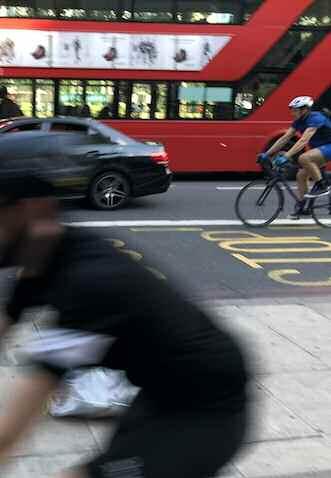
The case for transport policy encouraging more use of bicycles is very strong for three main reasons: cycling produces no air pollution or other harmful emissions; although the bus is the street transport mode that uses road space most efficiently in terms of moving people around, bicycles do so more efficiently than cars, certainly those carrying fewer than three people; cycling, being a good form of exercise, has considerable benefits for public health
The issue is not whether more cycling is a good or a bad thing – its is quite obviously a good thing – but whether the priorities of cycling policy and the approach of pro-cycling campaigning in the last ten years have been the right ones Have concerns about road safety, though perfectly right and proper, taken undue precedence, perhaps overly influenced by campaigners and misplaced public opinion Have the means used to address them been the most effective available? Has too much faith been placed in new road infrastructure to bring about change and too little attention been paid to other reasons why so many groups of Londoners – age groups, income groups, ethnic groups and women – might feel cycling is not for “people like us”? Has pro-cycling campaigning become a hindrance to enlarging the cycling demographic rather than a help?
The answers to such questions are not yet clear Perhaps more people should be asking them
Extracts taken from article, courtesy of Dave Hill, OnLondon co uk
My admiration for the work of actor Gene Hackman, all comes down to his role in The French Connection from 1971 Let’s have it right, that is a stellar film for so many reasons. Yes, Hackman has made some wonderful films since then and I’ll touch on some of them in a moment, but I watch The French Connection every time it comes around, just because, well, it’s there
Hackman is magnificent as Jimmy ‘Popeye’ Doyle, the spiky and mean New York detective, with a pork pie hat balancing on his combed over head of hair, as he runs around on the hunt for the leader of a French drug smuggling cartel If ever a role brought an actor to the attention of the movie fan in me as one to watch out for, that was the one

All right, Popeye’s here! Get your hands on your heads, get off the bar, and get on the wall!
He was born Eugene Allen Hackman in the January of 1930, in San Bernardino, California, to mum Anna and Dad Eugene Snr , a reporter for the local newspaper The family later moved to Danville, Illinois His parents divorced when he was 13, after his father just walked away from the family set-up, waving goodbye, never to return
‘It was a real adios. It was so precise Maybe that’s why I became an actor I doubt I would have become so sensitive to human behaviour if that hadn’t happened to me as a child if I hadn’t realised how much one small gesture can mean Acting was something I wanted to do since I was ten and saw my first movie, I was so captured by the action guys Jimmy Cagney was my favourite Without realising it, I could see he had tremendous timing and vitality ’
Hackman left home aged sixteen, lying about his age to enlist in the US Marine Corps, ending up serving four years as a radio operator, stationed first in China, then Japan and Hawaii Discharged in 1951, he landed in New York At first, he tried his hand at TV production, studying under the G.I. Bill of Rights, but gave up on that and moved to California, with his first wife Faye
Now I’m gonna bust your ass for
those three bags and I’m gonna nail you for picking your feet in Poughkeepsie.
There he joined the Pasadena Playhouse, and became good friends with another aspiring actor called Dustin Hoffman. They were both thought of as ‘no hopers’ by their classmates, with Hackman describing himself as a ‘big lummox kind of person’ and they were both voted ‘least likely to succeed ’
to get an audition, get a job ’ Never trust anyone!
Using that judgement as fuel to his fire, Hackman moved back to New York , where he met up again with Hoffman and another struggling thespian, Robert Duvall Staying close, they then shared apartments at various times, during the 1960s Gene worked various jobs to support himself, whilst trying to make a go of the acting game against a tide of apathy and ridicule
‘It was more psychological warfare, because I wasn’t going to let those fuckers get me down I insisted with myself that I would continue to do whatever it took to get a job It was like me against them, and in some way, unfortunately, I still feel that way But I think if you’re really interested in acting there is a part of you that relishes the struggle. It’s a narcotic in the way that you are trained to do this work, and nobody will let you do it, so you’re a little bit nuts You lie to people, you cheat, you do whatever it takes
Hackman’s mother died in 1962, before he hit it big, so never saw him make it He rarely speaks about her death, but it has been reported that she was drinking, then passed out in bed with a lit cigarette, starting a fire that killed her Slowly, he began to pick up small TV and film parts and he acted off Broadway Then things changed up big time, when he landed a decent part as Buck Barrow in the film Bonnie and Clyde, which earned him a Best Supporting Actor Academy Award nomination He picked up a second nomination in 1970 for I Never Sang for My Father, then scooped the big one, Best Actor, for his portrayal of Doyle in the film, directed by William Friedkin, from a screenplay by Ernest Tidyman
This is Doyle I’m sittin’ on Frog One
The Oscar now put him in the frame for leading man roles and over the next few years he appeared in big box office films like The Poseidon Adventure, in 1972, and The Conversation directed by Francis Ford Coppola in 1974. He was back as ‘Popeye’ Doyle in The French Connection II , with the film this time set in Marseilles He then appeared as Polish major general Sosabowski in A
Bridge Too Far in 1977 and as Lex Luthor in Superman in 1978 and its subsequent sequels in 1980 and 1987
The Westbury my ass! I got him on the shuttle at Grand Central, now what the hell’s going on up there?
Other notable parts saw him Reds in 1981, Hoosiers in 1986 and Missippi Burning in 1988, which brought him another Best Actor nomination He later followed that up as ‘Little’ Bill Daggett in Unforgiven from 1990 directed by Clint Eastwood , which earned him a Best Supporting Actor Oscar, with the film also picking up the Best Picture too,
Listen, I know the deal hasn’t gone down yet I know it! I can feel it, I’m dead certain
1993 saw him in The Firm alongside Tom Cruise , and he starred with Denzel Washington in Crimson Tide in 1995 In the same year, he starred in Get Shorty alongside John Travolta and Danny DeVito and in 1998, he was in Enemy of the State with Will Smith
Your hunches have been wrong before Jimmy
Going into his 70s, he was as busy as ever He starred in Heist in 2001 and The Royal Tenenbaum’s for Wes Anderson in the same year. He and his old pal ‘Dustbone’ –Dustin Hoffman – finally teamed up in Runaway Jury in 2003 Hackman then retired from acting after Welcome to Mooseport in 2004 When asked in 2011 , would he consider coming out of retirement , he replied ‘if I could do it in my own house, maybe, without them disturbing anything and just one or two people ’
In reality medical advice had forced the issue – ‘The straw that broke the camel’s back was actually a stress test that I took in New York The doctor advised me that my heart wasn’t in the kind of shape that I should be putting it under any stress.
When I’m actually on the set or on a stage, actually doing the work, I loved that process and I loved the creative process of trying to bring a character to life, and then, when you’re actually shooting or performing, there is a kind of a feeling that comes over you, a confidence and kind
of a wonderful, washed over feeling of wellbeing, if you will When it’s going well! Whereas the business part of show business is kinda wicked You jump from trying to be a sponge, if you will, in terms of input from other actors and the director and everything that’s surrounding you, you jump from that to a luncheon meeting with an agent and a producer on another film, or something that’s gone on, on the film that you’re doing It’s kind of a frying pan It was jarring and at my age and with my health, I decided I didn’t want to do that any longer ’
What was the weight of the car when it came in Irv?
Added to his acting career, he has written numerous books, with subjects including historical fiction, the American civil war, the old wild west and his last one to date, a police thriller 2013.
Gene – ‘It’s very relaxing for me I don’t picture myself as a great writer, but I really enjoy the process, We had to do a great deal of research and it is stressful to some degree, but it’s a different kind of stress It’s one you can kind of manage, because you’re sitting there by yourself, as opposed to having ninety people sitting around waiting for you to entertain them!’
Frog one is in that room…
Married twice, he has three children, and he lives in Sante Fe, New Mexico , at the grand old age of 92.
Director, Alan Parker – ‘Gene is someone who is very intuitive and an instinctive actor The brilliance of Gene Hackman is that he can look at a scene and he can cut through to what is necessary, and he does it with extraordinary economy he’s the quintessential movie actor He’s never showy ever, but he’s always right on ’
Asked how he’d like to be remembered Hackman said ‘As a decent actor As someone who tried to portray what was given to them in an honest fashion I don’t know, beyond that. I don’t think about that often, to be honest
I’m at an age where I should think about it ’
The Mumper of SE5
A couple of weeks ago I received a call from another taxi driver, that our mutual friend and ex london taxi driver, Mr John Kennedy had passed away



I knew John from when i was growing up in my late teens and “cutting my teeth” in various pubs around south London
The pub we both attended was called “The Rose” in Camberwell SE5 and at that time young men like ourselves in Lacoste polo necks and Pringle diamond jumpers talked about football, girls and work whilst drinking fancy beers out of a bottle
John was always a “larger than life” character and his passion for the london taxi
trade never diminished in all the years I knew him John was in the LCDC but when the RMT started a taxi branch and Bob Crow made a speech in the feeder park at Heathrow, that was it and he joined up and got involved in immediately as he loved Unions and what they represented to the working man
I remember talking with John as we jointly demonstrated against the “Killer On the Knowledge” outside Penton St, he had got there early carrying an umbrella and was taking it in turns with others to hollow at the PCO using a megaphone from the shop fronts opposite
John’s interests and ambitions didn't stop there,
he started Fox Terrier PR to support lobbying for the taxi trade, a bollard podcast and was a regular contributor to the well listened, BBC London phone show with Big George
John gave up the cab and moved to Cornwall with his
partner, Kim and spent many happy years there walking his fox terriers along the rugged and beautiful Cornish coastline
His funeral is on the 13th April at St Marks Church in Sticker, St Austell, Cornwall
It is not often in life that someone can light up a room when they come in, but I must say that John was just that, a live wire in every sense of the word and will be sorely missed by his family and the taxi trade
RIP John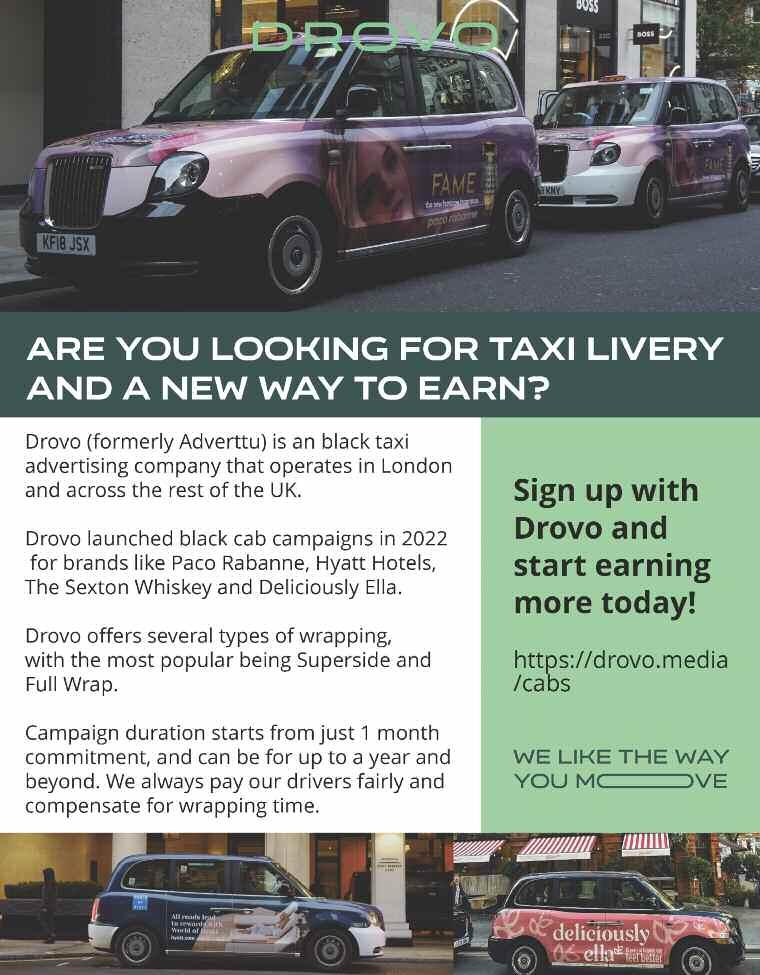
Martin Hills will be getting a close shave for charity in his local public house, The Duchess of Kent
Martin Hills is a regular in the Duchess of Kent in Northumberland Heath. Having spent many hours hearing stories from his friend, London Cab Driver Paul Cook about the Taxi Charity for Military Veterans, Martin decided he wanted to raise some money to support the veterans
Martin Hills said, “Paul is always telling me about what he does to support the Taxi Charity for Military Veterans and how they are totally reliant on donations to enable them to take veterans back to Normandy and the Netherlands as well as to events across the UK I decided that I wanted to help and after considering what I could do, I decided to shave off my beard I am well known for my beard as it’s my pride and joy but I think I can make this tiny sacrifice to support those men and women who sacrificed so much for our freedom ”
Paul Cook, London Cab Driver and Taxi Charity Volunteer, said “Everyone will enjoy seeing what Martin looks like under that beard! We might not even recognise him! I thoroughly enjoy volunteering

for the Taxi Charity and I have met some incredible men and women who fought in WWII when I have driven them to commemorations across the continent I am delighted that Martin wants to help by asking people to donate towards his beard shave.”
Dick Goodwin, Vice President, Taxi Charity for Military Veterans, said, “2023 is a very special milestone in the charity’s history as we are celebrating our 75th anniversary We are so thankful when people like Martin are inspired to raise funds for us and we are looking forward to seeing him clean shaven ”
Paul Cook will be taking one of the veteran’s the Taxi Charity supports to the Duchess of Kent on 23 April to witness the beard removal and to help pass a collection bucket around the pub
Martin continued, “I would love to raise £1,000 for the Taxi Charity I know everyone in the Duchess will get behind me and I am sure there will be plenty of volunteers offering to use the razor but I have said Paul can wield the blade and hopefully we will reach the target ”
If you would like to donate to support the work of the Taxi Charity, please visit www taxicharity org
The Taxi Charity is run by volunteer London black taxi drivers and has been supporting thousands of veterans since 1948. The charity arranges free trips (for
On 17 May, London cab driver and Taxi Charity volunteer Colin Mills from the village of Nazeing in Essex, will be setting off from Bowness-onSolway a village near Carlisle to walk the Hadrian’s Wall Path to celebrate his 60th birthday and attempt to raise £1,000 for the Taxi Charity.
London cab driver and Taxi Charity volunteer Colin Mills said, “It’s my 60th birthday this year and I wanted to do something to mark the occasion while raising funds for the Taxi Charity. So I decided to walk the Hadrian’s Wall path and roped in my two brothers, Tony and David, to do the 84 mile walk with me ”
Colin and his brothers are setting off on the 84 mile walk from Bowness-onSolway on the west coast on 17 May Along the route they will be stopping at Carlisle, Newton, Gilsland, Steel Rigg, Humshaugh, Heddon-on-the-Wall and Wallsend before finishing at South Shields
Colin continued, “As well as completing the length of Hadrian’s Wall, we will also achieve the unofficial coast to coast which I think will be a good way to mark my 60th and spending the time with my brothers will make the experience even better We have set ourselves a fundraising target of £1,000 for the Taxi
veterans from all conflicts) to the Netherlands and France, for acts of commemoration and days out to museums, concerts, or social events across the UK 2023 is the charity’s 75th anniversary, a remarkable milestone for a small, niche charity peopled by enthusiastic volunteers
The charity received the Queen’s Award for Voluntary
Service in 2021, an award approved by Her Majesty Queen Elizabeth II and the equivalent of the MBE for charities
To fund and facilitate their work, the charity is reliant on donations, grants and sponsorship and launched a ‘75 for 75’ fundraising campaign to raise £75,000 in its anniversary year. www taxicharity org
Charity, which may be a bit ambitious with everyone facing the current cost of living crisis but the charity does such wonderful things to support veterans that we will do all we can to reach this goal ”
Brian Heffernan, London Taxi Driver and Chairman of the Taxi Charity for Military Veterans said, “For the last seventy five years our small niche charity has relied on donations, grants and sponsorship and the goodwill of the amazing London cab drivers who volunteer their time for us These men and women are incredibly generous and so many, like Colin, go the extra mile to try and raise additional money to help us fund our trips for veterans ”
To support Colin, you can donate at https://www justgiving com/campaign/col in-mills-walking-hadrians-wall-for-taxicharity

To find out more about the support the Taxi Charity offers to veterans visit www taxicharity org

Londoner We will both hit barriers on the road to where we are going, but Ken was never afraid of speaking his mind
Steve Bunce insists all bets should be off when listing the runners and riders for Britain’s greatest ever fighter with Ken Buchanan the unopposed champion

The BBC boxing pundit paid tribute to his pal who died at the weekend at the age of 77 by claiming the Edinburgh born Scot’s ring career is now immortalised in legend As the passing of the former undisputed world lightweight champion was recognised by the great and good of the fight game, Bunce provided an insight into a talent who became unfashionable by the establishment for refusing to bend to their demands
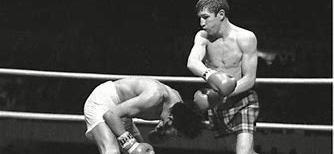
He said: “We need to drop the greatest Scottish boxer tag with Ken as there’s a really strong case to be made for him being the greatest ever British boxer Let’s be honest, he was far better than just being one of Scotland’s finest, he was one of the finest in Britain and was arguably Europe’s finest Let’s detail his career and the stuff he did
“In 197O he sent his belt back as he couldn’t make a living as a professional boxer, he was 22-
years-old and an undefeated young guy He sent his Lonsdale belt back to the board and then flew to Puerto Rico via New York to fight one of the greatest fighters of the 1960s, Ismael Laguna as a massive favour and beat him over 15 rounds
“That is the stuff of legends When we talk about the greatest wins by British fighters we have ever seen then that is probably it Then there was the run he went on at Madison Square Gardens, incredible ” Bunce holds both personal and professional affection for Buchanan and his memory is of a man who beat the best in their own backyard and never receiving the acclaim in his homeland for a succession of stunning achievements He said: “I wrote a history book about boxing and Ken loved the chapters and the mentions which I gave him
Undefeated as a pro and with some beefy names on his resume, Joe Joyce is still looking for his first world title shot And he's set to wait a little longer as he faces all-action fighter Zhang at the Copper Box in London
The winner, however, is expected to be ordered by the WBO to face the winner of Tyson Fury vs Oleksandr Usyk
With Zhang standing in Joyce's way, the Putney man will have to be switched on if
he wants to compete for his first world honours as a pro
When is Joyce vs Zhang?
Joyce's clash with Zhang will take place on Saturday, April 15
The main card gets underway from 7pm, with ring-walks for the main event expected at around 10pm UK time
Joyce vs Zhang will be held at the Copper Box Arena in London

What channel is it and can it be live streamed?
Joyce vs Zhang will be shown live on BT
1 in the UK
“I adored Ken as both a fighter and as a person It was a privilege to have met and worked with him a lot over recent years. When he first won the WBA title in 1970 he didn’t come back with a belt, they gave him a trophy and that is quite a big distinction
“He arrived back at the airport and it was only his wife and son who were waiting to greet him in Edinburgh There was no reception, nothing When he arrived back at his house he put his trophy on a table and then took a call from the British Boxing Board of Control telling him they are not going to recognise him as a world champion because they don’t recognise the WBA
“They only recognised the WBC So Ken has just pulled off one of the greatest achievements in boxing history and returned home without any fanfare only to be told the board
aren’t going to recognise it You can’t invent that type of crap Ken then packed his bag, including his tartan shorts and left for New York to sell out a fight which had Muhammad Ali on the undercard If that’s not mental then what is?”
The English pundit is in no doubt about Buchanan’s place in the boxing hierarchy and he admits he’s still astonished that the appreciation for the Scot extended well beyond these shores but never fully on his own doorstep He said: “Ken wasn’t fashionable enough for some but in New York, the greatest fight crowd in the world, with the most knowledgeable fans in the world, there were 22,000 people who came to see him fight
“I don’t understand it. There is all sorts of racism within British society, you know it as a Scot and I know it as a working class
“He wouldn’t kowtow or go cap in hand to anyone, certainly not the Lords and QC’s who were around the British Boxing Board of Control Ken fell out with them as he wouldn’t do a deal with the power brokers at British boxing and that’s why he wasn’t fashionable It had nothing to do with his fighting style or his heart, his art or his craft The New Yorkers recognised him and loved him ”
Bunce also hailed Buchanan as a boxing trailblazer for Scottish fighters from the past and present by being a class above the lot of them He said: “Young Scottish fighters of today can look back over the last 50 years can look at the likes of Gary Jacobs for perseverance, the Docherty brothers, Josh Taylor and Alex Arthur and Scott Harrison
“But none of those guys can do anything but look up to Ken Buchanan as he was at a different level I’ve tried to explain that to people on the radio and on British television What he did, what he achieved and who he was up against was just quite incredible “That’s before we get into Ken the man and the hardships which he suffered later on in his life There’s a phrase that you can celebrate a death but I can’t help but celebrate Ken’s death by remembering his astonishing achievements ”




Have You Had Heart Problems?

Do you need an Exercise Test and / or Echocardiogram (to measure LVEF) for LtpH?
We can help with our fast, efficient service and special low rates for London’s taxi drivers


We are now providing stress Echocardiography (functional testing) when required
We understand that your living can depend on these tests

or: 9 Church Road, Stanmore, Middlesex HA7 4AR

